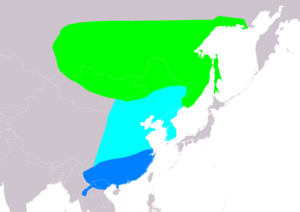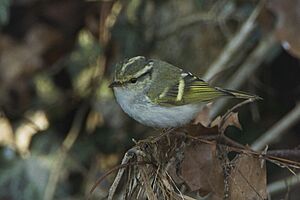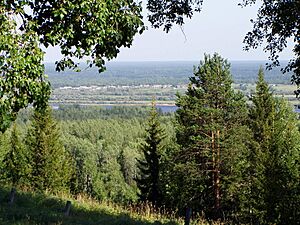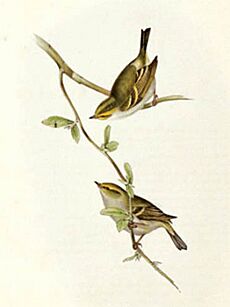Pallas's leaf warbler facts for kids
Quick facts for kids Pallas's leaf warbler |
|
|---|---|
 |
|
| Conservation status | |
| Scientific classification | |
| Genus: |
Phylloscopus
|
| Species: |
proregulus
|
 |
|
| Range of P. proregulus Breeding Passage Non-breeding | |
The Pallas's leaf warbler (Phylloscopus proregulus) is a small bird. It lives in mountain forests from southern Siberia to northern Mongolia and northeast China. This bird is named after Peter Simon Pallas, a German zoologist who first described it.
This leaf warbler travels long distances. It spends its winters mainly in south China and nearby parts of southeast Asia. In recent years, more of these birds have been seen in Europe during autumn.
Pallas's leaf warbler is one of the smallest warblers in its region. It has a fairly large head and a short tail. Its back is greenish, and its belly is white. It has a bright lemon-yellow rump (the area above its tail). You can also spot yellow stripes above its eyes, on its wings, and on top of its head.
This warbler looks a bit like other Asian warblers. Some of these were once thought to be the same species. But its unique songs and calls help tell them apart.
The female Pallas's leaf warbler builds a cup-shaped nest. She places it in a tree or bush. She lays four to six eggs and sits on them for 12–13 days until they hatch. The baby birds are fed mostly by the female. They leave the nest when they are 12–14 days old. Both parents then feed them for about another week.
Pallas's leaf warbler eats insects. It catches adult insects, their larvae (like caterpillars), and pupae. It also eats spiders. These birds look for food in bushes and trees. They pick insects off leaves or catch them in short flights. The Pallas's leaf warbler lives in a very large area. Its population numbers seem to be steady. Because of this, the International Union for Conservation of Nature (IUCN) lists it as a "least concern" species.
Contents
What's in a Name?
The English name for Pallas's leaf warbler honors Peter Simon Pallas. He was a German zoologist. He first found this bird in Siberia in May 1772. He named it Motacilla proregulus in 1811.
The bird's current genus name, Phylloscopus, comes from Ancient Greek words. Phullon means "leaf," and skopos means "seeker." So, it's a "leaf seeker." The second part of its name, proregulus, means "close to regulus." This refers to the goldcrest, Regulus regulus, which looks similar.
The Phylloscopus genus has about 50 species. These are small, insect-eating woodland warblers. They are usually green or brown on top and yellow, white, or buff underneath. This group of birds used to be part of the Old World warbler family. Now, they are in their own family called Phylloscopidae.
Pallas's leaf warbler belongs to a group of tiny Asian birds. They all have a yellow rump, a strong stripe over the eye, two wing bars, and a stripe on their head.
Scientists used to think Pallas's leaf warbler had several different types, called subspecies. The main type, P. p. proregulus, lived in northern Asia. Other types lived far south in the mountains of the Himalayas and western China.
For a long time, scientists didn't always agree on how important bird calls were. But now, bird sounds are very important for telling species apart. Even though the southern types of Pallas's leaf warbler look almost the same, their calls are very different. Their songs and calls are not like the main type. In 2006, DNA tests showed that these southern birds were different enough to be their own species. So, Pallas's leaf warbler is now considered a single species.
The species that were split off are:
- Lemon-rumped warbler (Phylloscopus chloronotus) in the Himalayas and southwest China.
- Gansu leaf warbler (Phylloscopus kansuensis) in central western China.
- Chinese leaf warbler (Phylloscopus yunnanensis) in western China.
These different species likely separated millions of years ago.
What Does It Look Like?
Pallas's leaf warbler is one of the smallest warblers. It has a large head and a short tail. It is about 9 to 10 cm (3.5 to 4 in) long. It weighs about 4 to 7 g (0.14 to 0.25 oz). This makes it a bit smaller than a yellow-browed warbler. It's barely bigger than a goldcrest.
Its back is greenish, and its belly is white. But it's very striking! It has bright yellow stripes on its wings. It also has bold yellow stripes above its eyes and a yellow stripe down the middle of its head. Its rump is lemon-yellow. Its beak is dark brown with a yellowish tint. Its eyes are brown, and its legs are brown with a green or gray hint. The yellow rump is easy to see when the bird is low or hovering. Otherwise, it can be hard to spot.
In Asia, you can tell Pallas's leaf warbler apart from its former relatives. Its head stripes, wing bars, and throat are yellower. Its calls are also different. Other yellow-rumped Asian warblers look similar. But the buff-barred warbler and Brooks's leaf warbler are larger and duller green. Their wing bars are buff or white, not yellow. The Ashy-throated warbler has gray head markings and a gray throat.
Male and female Pallas's leaf warblers look alike. Young birds look like adults but have a brownish tint on their backs. Adults get new feathers in August or September before they migrate. Young birds and adults before breeding get some new feathers in March or April.
Songs and Calls
The Pallas's leaf warbler sings from a hidden spot. It usually sings near the top of a tall tree. Its song is strong and long. It sounds like a mix of whistles, like "tirrit-tirrt-tirrit-terchee-choo-choo-chee-chee-chee." Some parts sound like a canary. It also includes trills. The song lasts 2–4 seconds. You might hear it in winter as well as during breeding season. Its call is a short, soft "dju-ee."
In contrast, the birds that used to be its subspecies have very different songs. Their songs are long rattles that last for seconds or even minutes. Their calls are usually sharp and single sounds.
Where It Lives and Travels
Pallas's leaf warbler breeds in coniferous taiga forests. These forests have trees like fir, spruce, pine, and larch. Sometimes, it lives in mixed forests with rhododendron and karsu oak. In southern Russia, it breeds up to 1,500–1,700 m (4,900–5,600 ft) high.
In winter, it uses more types of places. This includes broadleaf forests and bushes, as well as conifers. It can be found in river valleys as low as 100 m (330 ft).
Pallas's leaf warbler breeds in Siberia, from the Altai Mountains east to the Sea of Okhotsk. It also breeds in northern Mongolia, northeast China, and possibly North Korea. It is a strong migratory bird. It spends winter mainly in subtropical south China, northern Thailand, and other parts of northeastern Indochina. It is rare but seen every year in Japan.
Other Journeys
Pallas's leaf warbler is now seen regularly in Europe in autumn. The first time it was seen in Europe was in 1829 in Dalmatia (now Croatia). John Gould described it but didn't know it had already been found in Asia. He called it the "Dalmatian Regulus."
Later, a German ornithologist named Heinrich Gätke showed that several Asian birds, including Pallas's leaf warbler, were often found in Europe in autumn. In the UK, the first Pallas's leaf warbler was seen in 1896. By 1990, it was no longer considered a rare bird there. For example, in 2003, 313 were seen in Britain. It is also seen yearly in Sweden, Finland, and Denmark.
Most Pallas's leaf warblers found in Europe are young birds. Scientists have different ideas why so many are appearing in autumn. Some think they are just flying off course. Others believe they are trying to find milder places to spend the winter.
Outside Europe, Pallas's leaf warbler has been seen in north Africa (Tunisia and Morocco), western Asia (Israel, Turkey, and Iran), central Asia (Uzbekistan and Tajikistan), southeast Asia (Bangladesh and Taiwan), and Alaska.
Daily Life
Pallas's leaf warbler is not shy. But it's hard to see because it lives in trees and stays hidden. It is always moving. It often hovers briefly, like a goldcrest, but more often. It might even hang upside down.
Reproduction and Life Cycle
Nesting happens from June to July. Eggs are laid starting in mid-June. The female builds the nest in a conifer tree. It's usually next to the tree trunk, about 0.5–10 m (1.6–33 ft) above the ground. Sometimes it's in a bush. The nest is a round cup made of twigs, leaves, and other plants. It's lined with soft things like feathers or fine grasses.
The female lays four to six white eggs with blue-gray spots. She sits on them for 12–13 days. The chicks leave the nest when they are 12–14 days old. The female mostly feeds them while they are in the nest. But both parents feed them for about a week after they leave. In the southern parts of their range, a pair might have a second group of babies.
Like other birds in its group, Pallas's leaf warbler can be a host for the oriental cuckoo. This cuckoo is a brood parasite. This means the cuckoo lays its eggs in the warbler's nest. The cuckoo's egg looks similar to the warbler's, but it's bigger.
What It Eats
Pallas's leaf warbler eats insects. It eats adult insects, their larvae, and pupae. These include flies, moths, and aphids. It also eats spiders. The birds look for food in bushes and trees. They pick items off leaves. They also catch prey in short flights or while hovering.
When they are not breeding, they might join other birds to find food. They often join mixed groups with tits, goldcrests, and other warblers. In Asia, they might also join white-eyes, minivets, and babblers.
How It's Doing
The Pallas's leaf warbler lives in a very large area. Scientists haven't measured how its global population is changing. But they believe its numbers are stable. This species is not losing a lot of its population quickly. Because of this, the IUCN lists it as a "least concern" species. This means it is not currently at risk of disappearing.
Pallas's leaf warbler is common and found in many places in Russia and northeast China. In southeast Russia, there can be up to 35–50 pairs per square kilometer. It is also common in some of its wintering areas in southeast Asia.





